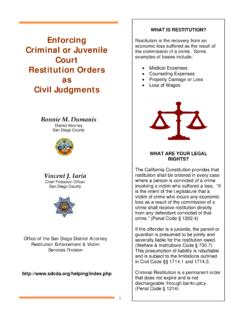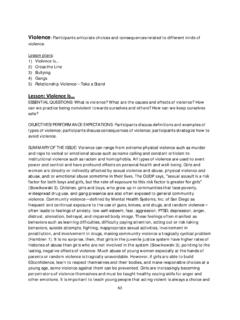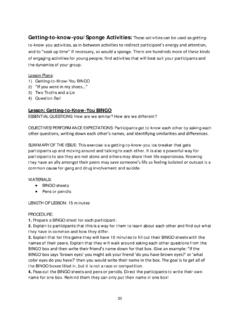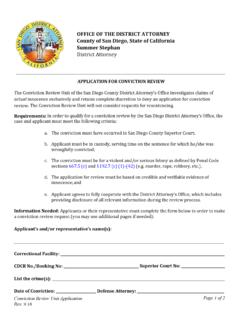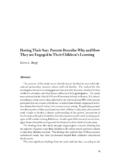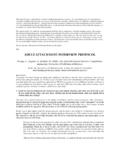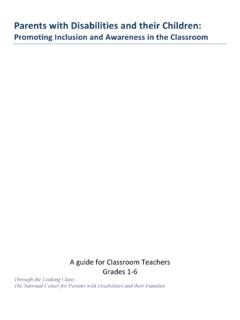Transcription of Emotions/Feelings
1 47 Emotions/Feelings : Participants identify emotions ; participants examine the role emotions and feelings play in their lives; participants practice healthy coping skills. Lesson plans: 1) emotions 2) Crinkle Heart 3) Stress balloon Lesson: emotions (adapted from Vangie Akridge and My Community Huddle, Inc.) ESSENTIAL QUESTION: What is a feeling or emotion? OBJECTIVES/PERFORMANCE EXPECTATIONS: Participants identify emotions ; participants describe their own feelings ; participants act out emotions . SUMMARY OF THE ISSUE: emotions or feelings are complex psychological and physiological reactions involving a person s state of mind and their surrounding environment.
2 emotions include feeling angry, jealous, happy, sad, scared, guilty, grief, joy, trust, nervous, annoyed, shy, envious, desirous, disappointed, worried, furious, proud, regretful. People often feel more than one emotion at a time and there are often multiple causes for someone s emotional state. emotions , feeling them, expressing them, or not expressing them, influence behaviors and actions; it is imperative to learn how to cope with emotions and how to express emotions in productive and positive ways so our actions can be aligned with how we wish to behave. MATERIALS: Tables or areas labeled according to age group Journals Pens or pencils Large posted list of emotions LENGTH OF LESSON: 45 minutes to 1 hour PROCEDURE: 1.
3 Participants sign in as they enter the room and sit at tables according to their age group. Have a volunteer or teacher sit at each table. 2. Introduce the topic by saying that today we will be talking about things that go on inside of our bodies, some things we can see and some things we cannot see. 3. Ask the group to think about their bodies. Ask the group to raise their hands and say some body parts that can move (examples: arms, legs, eyes, mouth). 4. Explain there are some things that go on in our bodies that make us human that we cannot move or see. Ask for examples from the group (ex: problems, feelings , emotions ). 5. Ask the group, what is a feeling or an emotion?
4 Ask the group to give some definitions. Explain what a feeling or an emotion is and give some examples. 6. Within the small groups at their table, have each student describe one feeling they had today. The volunteer or teacher at the table can further guide the students to describe another 48 feeling they had that day, a feeling they had on another day, or ask why they felt that way (this is where it is suitable to direct the conversation based on age appropriateness). 7. After having shared at their small groups, have the students share with the whole group some feelings that came up in their small group. 8. Have the girls volunteer to silently act out an emotion one at a time in front of the whole group.
5 Have the group guess what emotion is being acted out. 9. Have the girl stand in a line from shortest to tallest, facing the back of the person who is standing in front of them. Have the participants put their right hand on the shoulder of the person in front of them. Have them keep their hand on the shoulder and stretch out the line so that their arm is almost straight so that they have enough room to move. 10. Explain that for this activity, when a scenario is described that makes you feel good, stay standing up. When a scenario is described that doesn t make you feel good, squat down. Explain that there is an in between, that they can squat slightly if they don t feel all the way good or all the way not good, as emotions are rarely completely good or completely bad.
6 State various scenarios and have the girls react. Do about 10 scenarios. Sample scenarios: How do you feel when you get a good grade on a test and the teacher tells you that you did a good job? How do you feel when you don t get a good grade on a test? How do you feel when your best friend doesn t want to play with you at recess? How do you feel when you don t get to spend the night at a friend s house? How do you feel when you get to eat your favorite meal for dinner? How do you feel when your sister or brother gets to go somewhere that you want to go and you don t get to go? How do you feel when you win the talent show? How do you feel when you don t win the talent show?
7 How do you feel when you get to pick what movie you and your friends will watch? 11. Explain that as they could see from this activity, we all have ups and downs and that we should treat each other as sisters. 12. Have participants turn to a neighbor in the line and tell them how they are feeling right now. Direct participants to say the motto of Girls Only to their neighbor. 13. Remind participants that emotions are an important part of life and are what make us human! Ask the participants to think about their emotions throughout the next week and notice what different emotions they have. JOURNAL PROMPT: What is your favorite feeling to have?
8 When was the last time you had that feeling and what made you feel like that? What is your least favorite feeling to have? When has how you felt about something influenced how you acted? EVALUATION: Were the participants able to identify various emotions ? Were the participants engaged and participating in the discussion and activities in the lesson? RELATED ACTIVITIES: Participants can keep a feelings journal and track their emotions throughout the week. 49 Lesson: Crinkle Heart (adapted from Youthlight Inc. training, "Mean Girls- Strategies and Resources in Identifying and Helping Relationally Aggressive Girls and Empowering Their Victims") ESSENTIAL QUESTION: How powerful are words?
9 OBJECTIVES/PERFORMANCE EXPECTATIONS: Participants build empathy and demonstrate the power of words (both positive and negative). SUMMARY OF THE ISSUE: Words are powerful. Teasing, bullying, cattiness, name calling, gossiping, and discriminatory language can lead to depression, low self-esteem, drug and alcohol abuse, and even suicide. Similarly, compliments and kind language can build self-esteem and boost confidence. Teaching young people to use alternatives to language that hurts others and use language they are proud of helps facilitate effective communication and can help them avoid conflict. MATERIALS: Large paper cut-out of a heart Paper heart cut-outs for each participant LENGTH OF LESSON: 20 minutes PROCEDURE: 1.
10 Begin by asking the participants to raise their hands if they ve ever had their feelings hurt by something someone said. Notice that most of us have had our feelings hurt by words. 2. Ask them to raise their hands if they have ever hurt someone s feelings using words. 3. Explain that this activity is going to show how powerful words are they can make someone feel really great or really terrible. 4. Show the large paper cut-out heart. Pass out a paper heart cut-out for each participant. Explain that this is a symbol of our own heart. 5. Explain that we re going to talk about words and actions that hurt us and make our hearts hurt.

